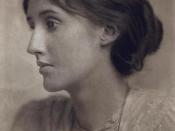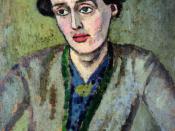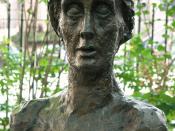The Suicide of the Author and his Reincarnation in the Reader: Intertextuality in The Hours by Michael Cunningham
Andrea Wild
In his novel The Hours, Michael Cunningham weaves a dazzling fabric of intertextual references to Virginia Woolf's works as well as to her biography. In this essay, I shall partly yield to the academic itch to tease out the manifold and sophisticated allusions to the numerous intertexts. My aim, however, is not to point out every single reference to Woolf and her works--such an endeavour of source-hunting would fail alone because of the sheer abundance of intertextual references--and to strip The Hours down until its threads lie bare in front of me, but to take the theories of influence (as voiced, for example, by Bloom) and their concept of a unidirectional relationship between an anterior text and a posterior text as a point of departure to investigate how Cunningham manipulates and transforms the anterior texts and, accordingly, establishes a two-way relationship between himself and Woolf.
The critical term of intertextuality was coined in 1966 by Julia Kristeva, who -- following Mikhail Bakhtin -- writes in her ground-breaking essay "Word, Dialogue, and Novel" [1] : "[E]ach word (text) is an intersection of word [sic] (texts) where at least one other word (text) can be read . . . . any text is constructed as a mosaic of quotations; any text is the absorption and transformation of another" (66). However, as Kristeva in a later interview explains, the dynamics of intertextuality does not only take place between author and text but also between text and reader: "If we are readers of intertextuality, we must be capable of the same putting-into-process of our identities, capable of identifying with the different types of texts, voices, semantic, syntactic, and phonic system at play in a...



Excellant Essay!
This was extremely well written. I have never seen the movie, and barely covered any of the terms you have discussed, so my understanding is entirely from just reading it. (Probably because I am a Freshman in high school and this definitly must be a college essay) As for intertextuality, I don't think you gave a good "definition" of it. You thouroughly described when it was invented, who coined the word, and where it was first used, but I never did quite understand the word, and if the reader does not understand the introduction, the rest is lost. Anyway, intertextuality is relating to or deriving meaning from the interdependent ways in which texts stand in relation to each other. A few other things I caught though were mainly grammatical, or that could be reworded. The last sentence of your 6th paragraph is made up of a lot of (;)'s, (-)'s, and (,)'s. It is in fact correct, but it makes the subject drag on. It could be better. Besides a few things like that here and there, I have one other thing to mention. I liked that you provided an oustantding amount of quotes to prove your statements, but it is better to incorporate them into your body paragraphs. With a substantial amount of your quotes, you placed them in their own paragraphs, and in the following paragraph, stated "as I have shown above" or "as shown above" etc. By placing these quotes in the actualy paragraph you are using them in, it creates a much smoother transition. However, how you did it was fine, just would make the essay easier to read rather than jumping to quotes without knowing why. Overall, this was very well written and I am glad you included your bibliography and footnotes. I wish you included your grade too, as I am interested as to what your teacher would have given you. This paper deserves nothing less than an A.
0 out of 0 people found this comment useful.